How to connect multiple led strips to one power source?
Contents
- 1 Full Guide: Connecting Multiple LED Strips to One Power Source
- 2 Review of Connection Methods
- 3 Key Takeaways
- 4 FAQs
- 4.1 Should I connect LED strips in series or parallel?
- 4.2 Can I connect multiple LED strips to one power supply?
- 4.3 How do I calculate what size power supply I need?
- 4.4 What happens if my power supply is too small?
- 4.5 Do I need a special connector?
- 4.6 What wire size should I use?
- 4.7 Can I run LED strips of different lengths together?
- 4.8 Can I mix 12V and 24V LED strips on the same power source?
Full Guide: Connecting Multiple LED Strips to One Power Source
1. Check Voltage & Compatibility
- Most LED strips are 12V or 24V DC.
- Your power supply must match the strip’s voltage exactly. (12V strip → 12V power supply).
- Mixing voltages can burn out strips or make them not light up.
👉 First, confirm: Are your strips 12V or 24V?
2. Calculate Total Power Needed
- Each strip has a wattage per meter/foot (e.g., 14.4 W/m).
- Multiply by length of strip → total watts.
- Add all strips together → total power demand.
- Always size your power supply 30% higher than total load for safety.
Example:
3 strips × 5m each at 14.4 W/m = 216W total.
216W × 1.3 safety factor ≈ 280W supply needed.
3. Decide Connection Method
There are three main ways to connect multiple strips:
A. Daisy-Chaining (End-to-End)
- Connect strip 1 to strip 2, then strip 2 to strip 3.
- ❌ Not recommended for long runs (>5m), because voltage drop will cause dimming.
B. Parallel Connection (Best Method)
- Run wires from the power supply to each strip’s beginning.
- All strips get equal voltage, brightness is consistent.
- ✅ Recommended for most installations.
C. Amplifier/Repeater Method (for RGB/RGBW strips)
- If using controllers (like with color-changing strips), use LED amplifiers to boost the signal + power after every few meters.
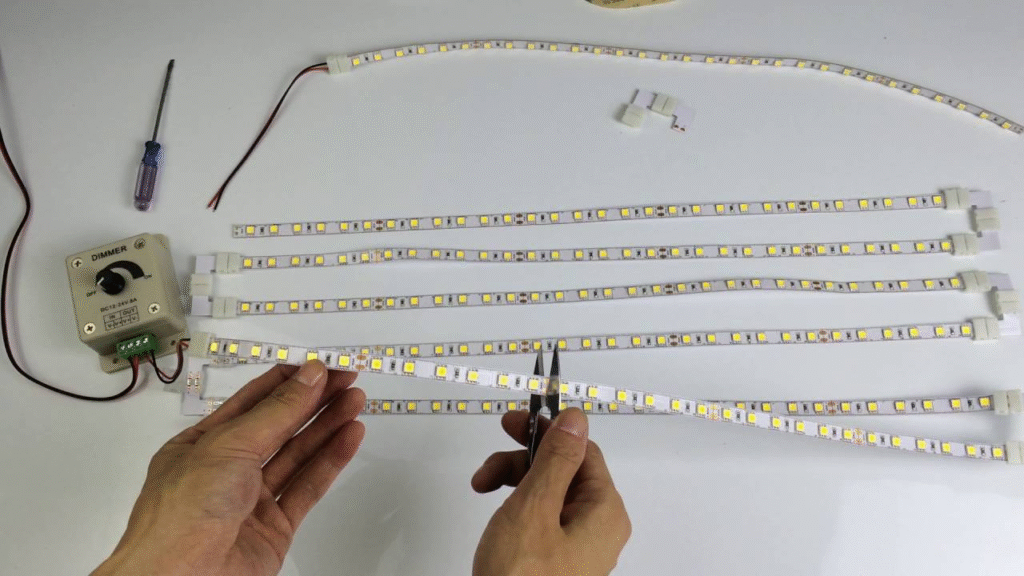
4. Wiring Setup
- Use a sufficient wire gauge. Longer runs or higher wattage require thicker wire (e.g., 18AWG for short, 14AWG for long runs).
- Keep wire lengths as short as possible to reduce voltage drop.
- Use soldering or LED connectors for clean joins.
- Observe polarity (+ and – must match), or the strip won’t light.
5. Optional: Add a Controller or Dimmer
- For single-color strips: inline dimmers are fine.
- For RGB/RGBW: use a controller rated for your total current load.
- Controllers often also need a power supply rated for all strips combined.
Review of Connection Methods
✅ Parallel Wiring
- Even brightness across all strips.
- Easy to troubleshoot if one strip fails.
- Scales well for long or multiple strips.
- Requires more wiring effort.
⚠️ Daisy-Chaining
- Simple, less wiring.
- Only suitable for short runs (under 5m for 12V, ~10m for 24V).
- Voltage drop leads to color shift/dimming.
🔄 Amplifiers/Repeaters
- Best for large RGB/RGBW setups.
- Allows synchronization across long runs.
- Slightly more expensive, adds complexity.

Key Takeaways
- Always match voltage (12V with 12V, 24V with 24V).
- Size power supply at least 30% higher than total load.
- Use parallel wiring for even brightness.
- For RGB, use amplifiers or controllers.
- Pay attention to wire gauge to avoid overheating.
FAQs
Should I connect LED strips in series or parallel?
Parallel connection (each strip connected directly to the power source) is the best option.
Series/daisy-chaining (end-to-end) causes voltage drop and uneven brightness beyond ~5m (12V) or ~10m (24V).
Can I connect multiple LED strips to one power supply?
Yes, as long as the power supply can handle the total wattage of all strips combined. Always choose a supply rated 30% higher than the calculated load.
How do I calculate what size power supply I need?
Find the strip’s wattage per meter (or foot).
Multiply by the length of each strip.
Add them together for total watts.
Multiply by 1.3 (30% safety margin) → that’s your minimum power supply size.
What happens if my power supply is too small?
Strips may flicker, dim, or not turn on.
Power supply can overheat and fail.
Do I need a special connector?
Not always. You can:
Solder wires directly for strongest connection.
Use clip-on LED connectors for quick installation.
For RGB/RGBW strips, use connectors that match the number of pins (4-pin, 5-pin).
What wire size should I use?
Short runs (<2m): 18 AWG wire is fine.
Longer runs / high wattage: 16 AWG or 14 AWG to reduce voltage drop.
Can I run LED strips of different lengths together?
Yes, but calculate total wattage. Each strip in parallel will draw the current it needs
Can I mix 12V and 24V LED strips on the same power source?
No. Voltage must match exactly. A 12V strip on 24V will burn instantly.
READ ALSO: How to Change a 2-Pin Halogen Light Bulb (Step-by-Step Guide)


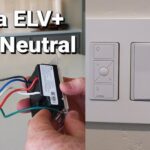

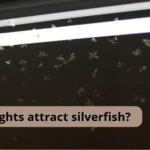
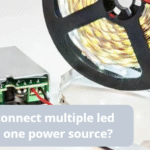

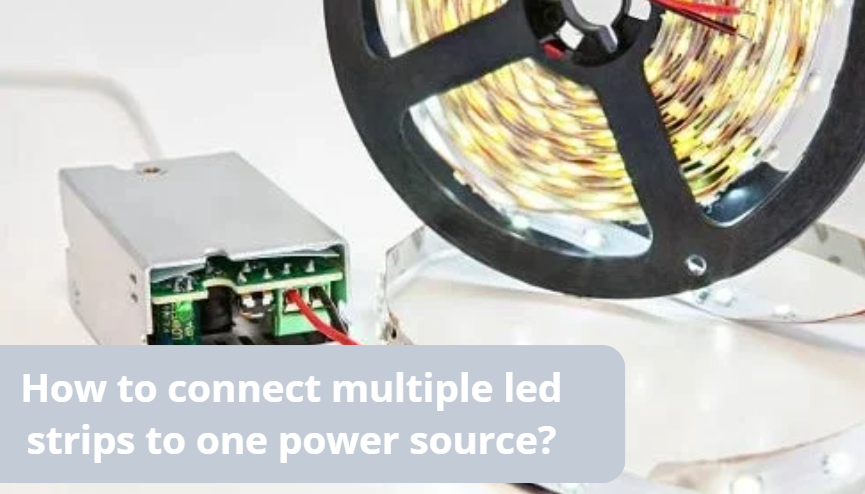



![Do LED lights get hot enough to start a fire? [6 risk factors] Do Led Lights Get Hot Enough To Start A Fire: Top 6 Causes](https://howtolightguide.com/wp-content/uploads/2024/04/howtolightguid-10.jpg)